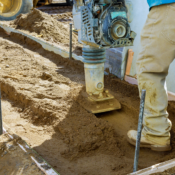
Mothballed Construction Sites Part 1: Leaving the Site
[vc_row][vc_column][vc_column_text]
Mothballed construction sites Part 1: Leaving the site
This current situation opens up a host of new risks arising from the cessation of work, the biggest being an unoccupied property which presents a range of issues that must be addressed quickly.
In this article, Ensurance provide advice on some new risks and offer some simple best-practice advice and guidance to try and mitigate some of these new challenges.
Cessation of works
First and foremost, clients should be notifying their broker and insurer of any unplanned cessation of work. The majority of policies contain this extension, whether it’s for 30 days or 6 months and beyond, and the earlier the opportunity to notify the insurer the better.
Typically, you should be asking 4 key things:
- Why is the risk suspended?
- Have there been any incidents which may lead to a claim?
- How are they securing the site?
- What is a reasonable date for works to recommence?
Finding out these key bits of information can usually give risk engineering and insurers enough initial information to move things forward.
COVID-19 FAQ's
Leaving a site
In recent years there has been an increase in sites becoming the victim of financial circumstances and being mothballed or left altogether, in these situations it is important to leave the site in a clear and well organised state to reduce the risk of both potential damage, and injury to third parties.
The location of the project will often dictate the level of attention needed; you should be considering, for example, whether it’s by a school, it’s not uncommon for children to access a poorly secured site and cause injury to themselves. Is the site in a remote area where theft is unlikely? Are people living on-site? Is it in a built-up area where theft of materials is likely?
Construction mistakes – The use of subcontractors
There has also been a rise in custodians and companies specialising in securing and occupying sites, which have been mothballed. Whether this is a temporary or long-term cessation, it means there is a presence on-site which will often satisfy insurers.
The biggest risk for partially complete projects is fire. Combustible materials and waste, stored materials and packaging, bubble wrap, paper, plastics, and foam, we’ve seen many claims arising from the unsafe storage of materials. Care should be taken to assess the storage arrangements on-site but where possible, combustible materials should be removed completely.
Once the initial decision has been made to suspend work on a project, these are some of the first things you and your client should be taking into consideration in order to mitigate some of the risks associated with a vacant site.
To find out more about how to protect your business in these unprecedented times please click here.
Please contact Simon Horton or David Baker at Ascend Broking Group to discuss any of your requirements – info@ascendbrokingold.co.uk
Telephone: 01245 449060
Author: Ensurance Insurance and Daisy Ambrose, Ascend Broking
[/vc_column_text][/vc_column][/vc_row]





